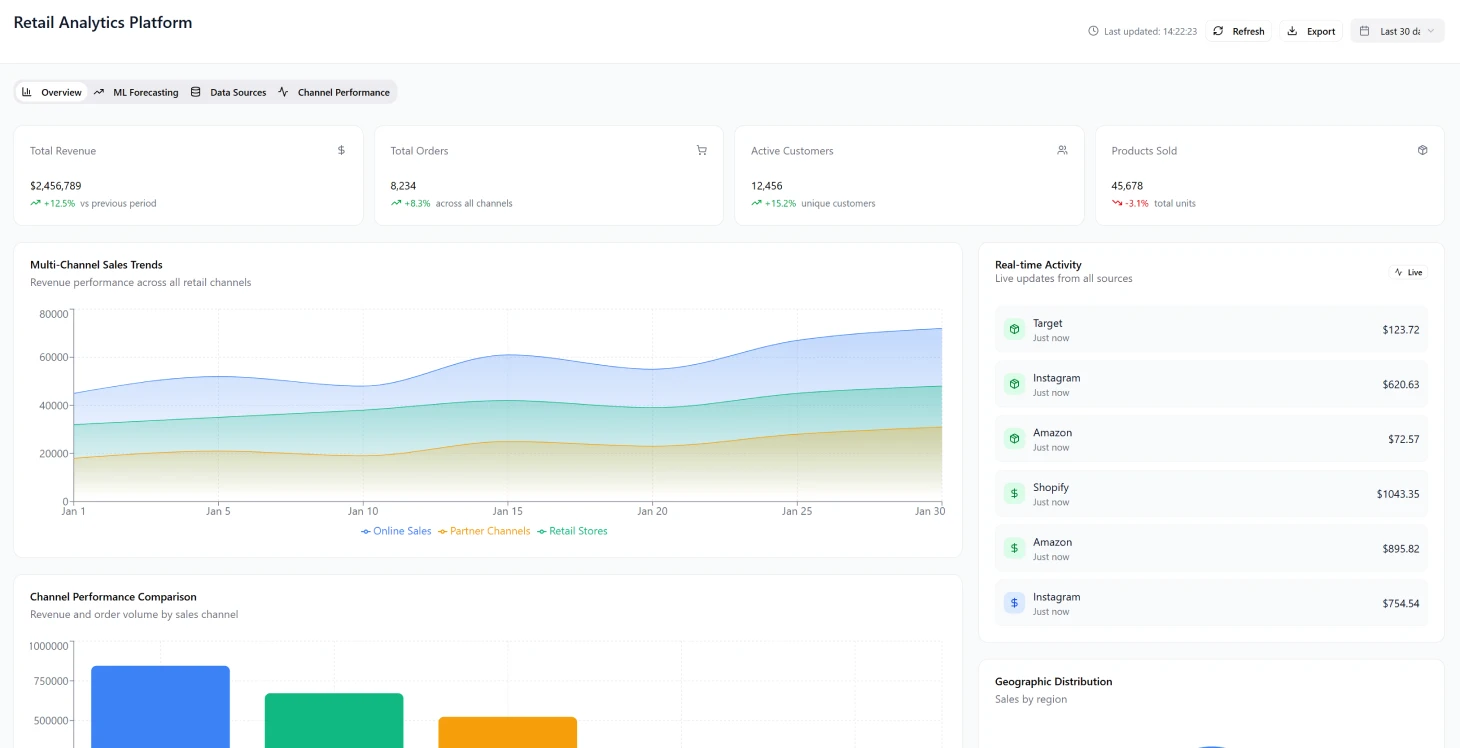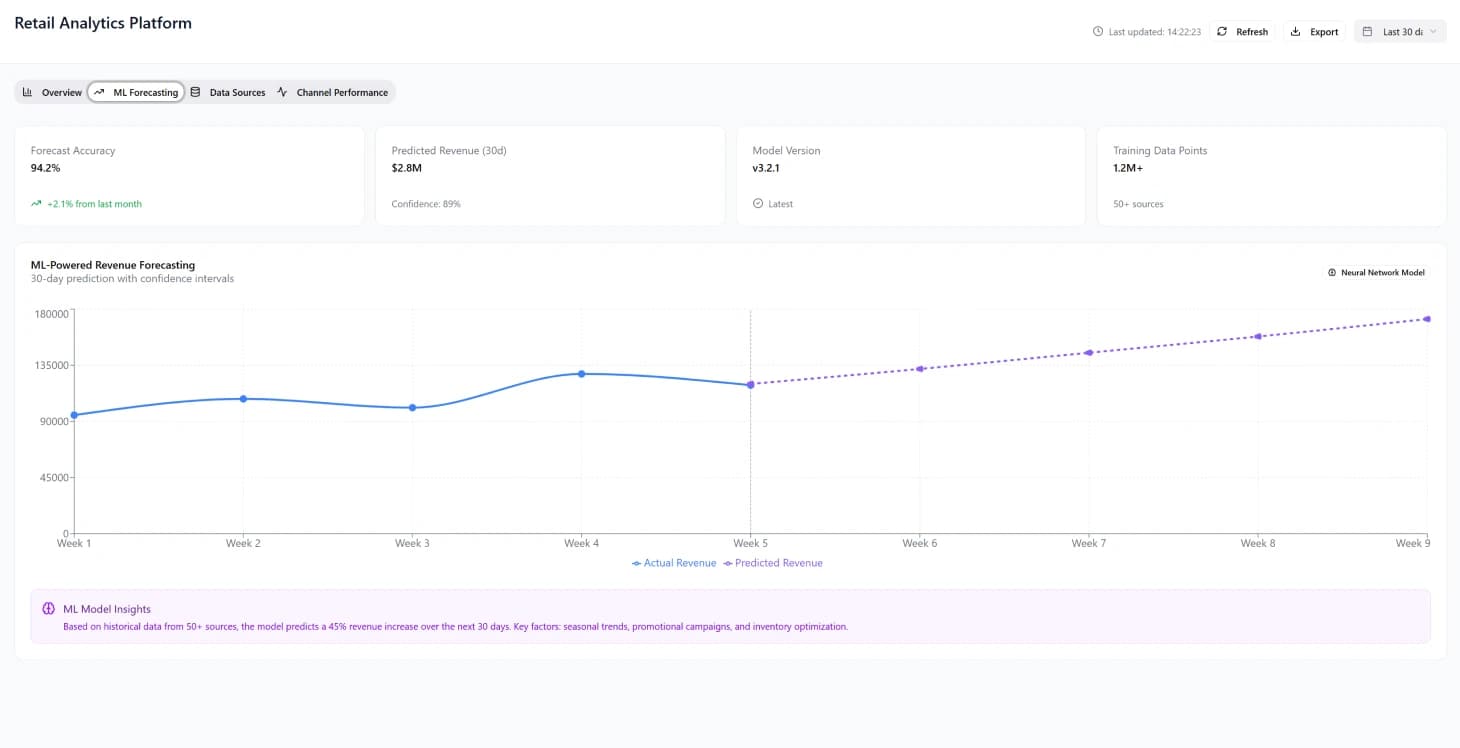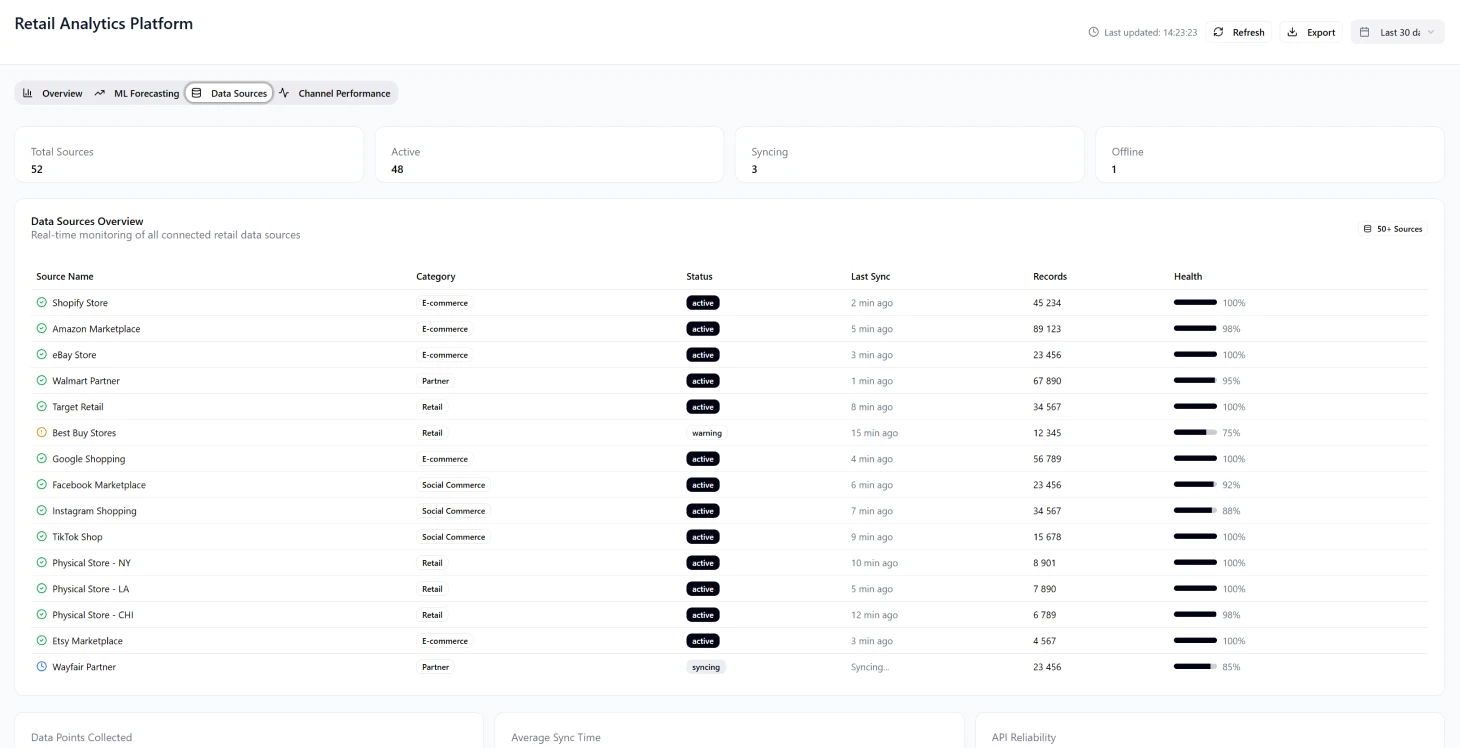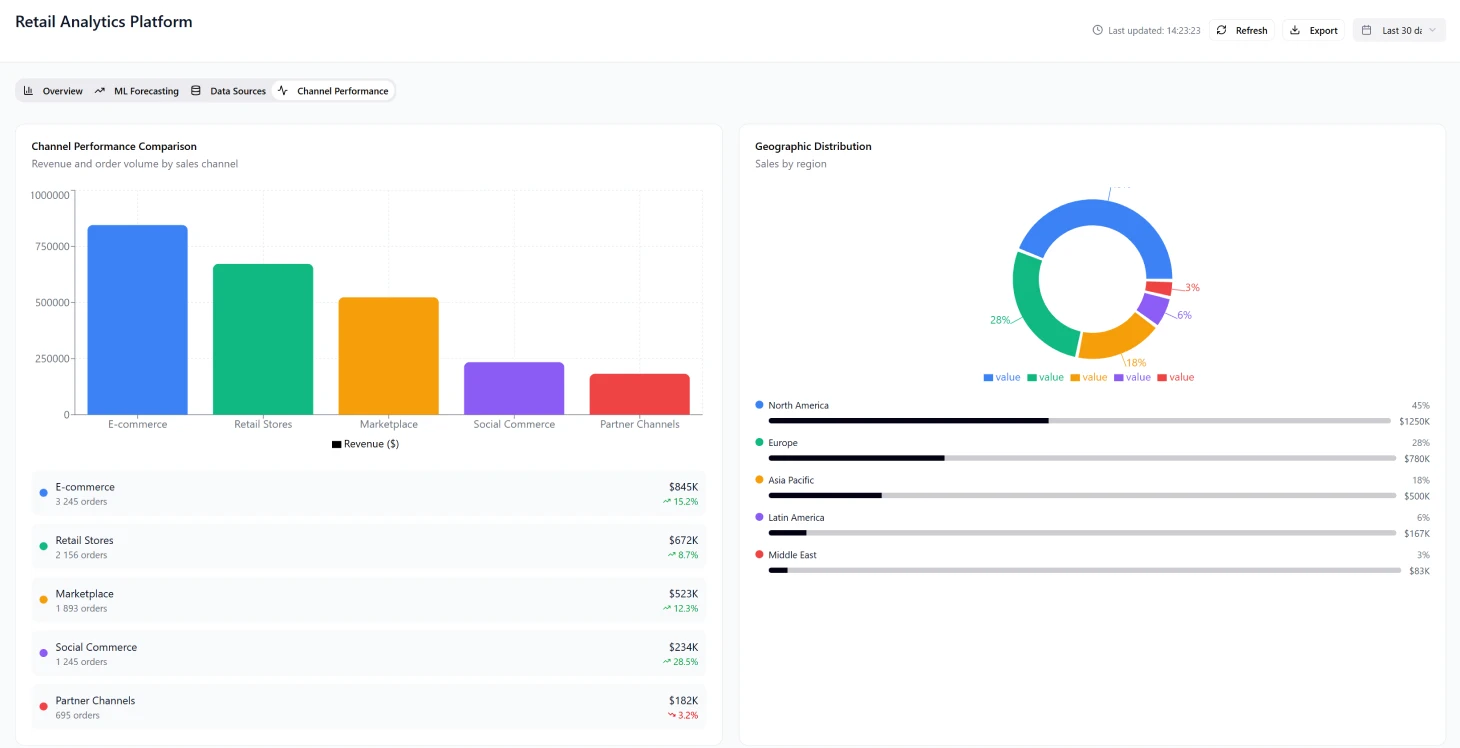



Project Overview
Retail companies faced significant challenges with data being spread across multiple sources like online platforms, physical stores, and partner channels. This fragmentation made it difficult to analyze overall brand performance comprehensively and make strategic decisions effectively.
The Solution: Advanced Analytics Platform
A software platform designed for analytics was created with the goal of automating data collection from over 50 retail sources in real-time. The platform offered forecasting features powered by machine learning (ML) capabilities.
The implementation significantly accelerated insight generation from weeks to hours and improved forecast accuracy by 34%. Additionally, it enabled comprehensive campaign performance assessment with 89% coverage across all touchpoints.
Industry Transformation Challenges
Multi-Channel Complexity
The retail industry has transformed into a complex network where companies need to manage operations across:
- Physical stores
- E-commerce websites
- Social commerce channels
- Emerging marketplaces
These various channels produce different types of data and performance metrics, creating barriers to obtaining a unified view of overall brand performance.
Real-Time Decision Making Demands
Retail brands must manage marketing budgets across multiple platforms simultaneously and make quick campaign adjustments based on real-time performance data analysis. Conventional business intelligence tools were not designed to handle the speed and scale of modern retail data, often resulting in:
- Delayed insights
- Missed optimization opportunities
- Reactive rather than proactive strategies
Core Implementation Challenges
Data Fragmentation Issues
- Sales data spread across systems such as POS terminals and e-commerce platforms
- Manual data consolidation efforts causing analyst delays
- Hindered quick decision-making adjustments
- Limited historical analysis capabilities without seasonal trend consideration
Attribution Modeling Complexity
The rise in customer interaction points added complexity to attribution modeling, making it challenging to determine which marketing efforts yield the best results for various customer groups and buying paths.
Transform Your Retail Analytics Today
Discover how unified data management can accelerate your decision-making process.
Performance Measurement Inconsistencies
Marketing teams faced challenges evaluating campaign success across platforms, often realizing poor performance weeks after resource allocation. Success across channels was measured using misaligned metrics and KPIs, making it difficult to:
- Set unified performance standards through professional blockchain consulting
- Distribute resources effectively
- Scale reporting systems cost-efficiently
Solution Architecture
Foundation Design
The foundation design revolved around a cloud-based data system that could process and enhance information from multiple origins almost instantly, focusing on:
- Scalability across different channels
- Adaptability to expansions without significant structural changes
- Schema-on-read data ingestion for managing changing API formats
- Event-based processing for real-time updates
- Microservices architecture for independent scaling
Core Components
Data Ingestion Layer
- Event-triggered connectors for REST APIs and webhook endpoints
- Support for file uploads and database replication streams
- Built-in retry logic and circuit breakers
- Reliable data acquisition from retail systems
Real-Time Processing System
- Distributed streaming platform for normalizing data events
- Capacity to manage over 500,000 events per hour
- Low-latency processing for critical metric updates
Data Lake Storage
- Cloud-based object storage organized by date
- Categorized by brand and channel for query efficiency
- Retention policies balancing storage costs and compliance
Machine Learning Pipeline
- Automated training and deployment for demand forecasting
- Price optimization and customer segmentation
- Weekly model updates with continuous learning
- Seasonal variation accommodation
Implementation Timeline
Phase 1 (Months 1-3)
- Built base infrastructure including data lake system with enterprise blockchain architecture
- Established streaming platform
- Integrated basic API connections for five leading retail channels
- Implemented security framework
- Established CI/CD pipelines for automated deployment
Phase 2 (Months 4-6)
- Set up analytics engine with feature engineering pipeline
- Crafted machine learning models for demand prediction
- Launched beta dashboard with KPI visualizations
- Onboarded initial ten customer brands for validation
Phase 3 (Months 7-8)
- Incorporated over 45 channel connectors
- Introduced attribution modeling techniques
- Rolled out sophisticated forecasting algorithms
- Set up auto-scaling infrastructure
Results and Impact
Performance Improvements
Key Performance Metrics
| Metric | Before | After | Improvement |
|---|---|---|---|
| Insight Generation Speed | Weeks | Hours | 95% faster |
| Forecast Accuracy | Baseline | +34% | 34% increase |
| Campaign Coverage | Limited | 89% | 89% coverage |
| Stock Reduction | High levels | -18% | 18% decrease |
| Stock Shortages | Frequent | -22% | 22% reduction |
Business Value Creation
- Customer Lifetime Value: 40% increase through unified attribution modeling
- Marketing ROI: 23% boost through optimized fund reallocation
- Conversion Rates: 15% improvement via real-time A/B testing
- Order Value: 12% increase across all platforms
- Cost Reduction: Eliminated three full-time analyst positions
Customer Adoption Success
Customer acceptance surpassed expectations with 85% of trial users upgrading to premium subscriptions within 60 days. The Net Promoter Score increased by 109%, reaching 67 points.
Technical Achievements
System Performance
- Dashboard load time: Less than 2 seconds (95th percentile)
- Customer onboarding: Completed within 3 days
- Anomaly detection: 2-4 days faster than manual review
- Revenue loss prevention through proactive inventory adjustments
Operational Efficiency
Cross-channel visibility helped marketing teams discover hidden combinations that resulted in conversion rates three times higher than single-channel campaigns.
Implementation Challenges and Solutions
API Evolution Management
The complexity of evolving APIs without backward compatibility required:
- Robust schema versioning strategies
- Graceful degradation approaches
- Early implementation of schema registries
- Prevention of data quality problems
Seasonal Volume Management
Retail data shows significant fluctuations, with Black Friday activity spiking to 20 times normal volume. Managing costs while maintaining performance required:
- Efficient auto-scaling strategies
- Dynamic resource allocation
- Performance optimization during peak times
Data Quality Assurance
Inconsistencies in data quality among channels led to downstream analytics problems. Solutions included:
- Automated data profiling
- Quality scoring systems
- Prevention of ML model errors from poor input data
Technology Stack
Infrastructure Components
- Container Orchestration: Kubernetes
- Infrastructure Management: Terraform
- Monitoring: Prometheus metrics and Grafana dashboards
- Alerting: PagerDuty integration
- Security: Vault secrets management, AWS IAM with comprehensive security audits
- Encryption: Data protection at rest and in transit
Effective customer expectation management proved crucial, especially regarding historical data migration timelines of 2-3 weeks due to API rate limits.
User Experience Optimization
The balance between feature complexity and usability was critical in dashboard development. Initial designs packed with metrics overwhelmed users, but user research revealed that 80% of value derived from just six core KPIs. This led to:
- Streamlined default views
- Advanced options available on request
- Improved user experience and adoption rates
Future Considerations
Privacy and Identity Management
Addressing channel attribution complexities requires precise customer identity reconciliation across platforms, especially considering:
- Cookie limitations and privacy mandates
- Need for probabilistic matching methods over definitive connections
- Compliance with evolving data protection regulations
The platform's success demonstrates the transformative power of unified retail analytics, enabling data-driven decision making and significant business value creation across the retail ecosystem.
Project Results
- 95% faster insight generation (weeks to hours)
- 34% improvement in forecast accuracy
- 89% campaign coverage across all touchpoints
- 40% increase in customer lifetime value through [fintech solutions](/fintech-solutions)
- 85% trial-to-premium conversion rate
Key Performance Metrics
Insight Speed
Faster insight generation
Forecast Accuracy
Improvement in predictions
Campaign Coverage
Across all touchpoints
Customer LTV
Lifetime value increase


